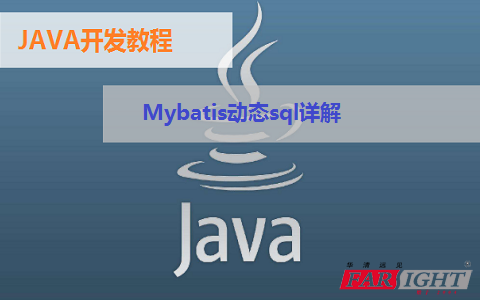今天为大家分享一下Mybatis动态sql方面的内容。

什么是动态SQL?
MyBatis的一个强大特性之一通常是它的动态SQL能力。如果你有使用JDBC或其他相似框架的经验,你就明白条件串联SQL字符串在一起是多么地痛苦,确保不能忘了空格或者在列表的后的省略逗号,动态SQL可以彻底处理这种痛苦。
通常使用动态SQL不可能是独立的一部分,MyBatis当然使用一种强大的动态SQL语言来改进这种情形,这种语言可以被用在任意映射的SQL语句中。
动态SQL元素和使用JSTL或其它相似的基于XML的文本处理器相似,在MyBatis之前的版本中,有很多元素需要了解,MyBatis3大大地提升了它们,现在用不到原先一半的元素就能工作了,MyBatis采用功能强大的基于OGNL的表达式来消除其他元素。
OK,介绍就到这儿,下面来进入动态SQL的学习吧。
if
在动态SQL中所做的通用的事情就是包含部分where子句的条件,比如:
<select id="selectInCondition" parameterType="student" resultType="student">
select * from student where studentId > #{studentId}
<if test="studentName != null">
and studentName = #{studentName};
</if>
</select>
具体实现不写了,那么如果我这么调用:
List<Student> list = StudentOperator.getInstance().selectInCondition(0, "Jack", 0, null);
查询的就是studentId>0且studentName="Jack"的所有学生信息,如果换一种调用方式:
List<Student> list = StudentOperator.getInstance().selectInCondition(0, null, 0, null);
那么查询的就是studentId>0的所有学生信息。
多个where子句也是一样的,比如:
<select id="selectInCondition" parameterType="student" resultType="student">
<![CDATA[
select * from student where studentId > #{studentId}
]]>
<if test="studentName != null and studentName != 'Jack' ">
and studentName = #{studentName}
</if>
<if test="studentAge != 0">
and studentAge = #{studentAge};
</if>
</select>
注意一下,能用""尽量还是用,不过只包动态SQL外的内容。
另外,test里面可以判断字符串、整型、浮点型,大胆地写判断条件吧。如果属性是复合类型,则可以使用A.B的方式去获取复合类型中的属性来进行比较。
choose、when、otherwise
有时候我们不想应用所有的应用条件,相反我们想选择很多情况下的一种。和Java中的switch...case...类似,MyBasit提供choose元素。
上面的例子是两种if判断都可能存在,接下来使用choose、when、other做一些修改:
<select id="selectInCondition" parameterType="student" resultType="student">
<![CDATA[
select * from student where studentId > #{studentId}
]]>
<choose>
<when test="studentName != null">
and studentName = #{studentName};
</when>
<when test="studentAge != 0">
and studentAge = #{studentAge};
</when>
<otherwise>
or 1 = 1;
</otherwise>
</choose>
</select>
两个when只能满足一个,都不满足则走other。还是注意一下这里的"",不可以包围整个语句。
trim、where、set
第一个例子已经示例了if的用法,但是这种用法有个缺陷----动态SQL外必须有where子句。
什么意思,因为很多时候我们需要where后面的子句都动态生成,而不是事先有一个where,这样就有问题,比如说:
<select id="selectInCondition" parameterType="student" resultType="student">
<![CDATA[
select * from student where
]]>
<if test="studentName != null and studentName != 'Jack' ">
and studentName = #{studentName}
</if>
<if test="studentAge != 0">
and studentAge = #{studentAge};
</if>
</select>
如果所有条件都不匹配,那么生成的SQL语句将是:
select * from student where
这将导致查询失败。即使只满足一个查询条件还是有问题,比如满足studentName那个吧,生成的SQL语句将是:
select * from student where and studentName = #{studentName};
这个查询也会失败。
解决办法也有,一个讨巧的办法是用where 1 = 1的方式,即:
<select id="selectInCondition" parameterType="student" resultType="student">
<![CDATA[
select * from student where 1 = 1
]]>
<if test="studentName != null and studentName != 'Jack' ">
and studentName = #{studentName}
</if>
<if test="studentAge != 0">
and studentAge = #{studentAge};
</if>
</select>
因为"1 = 1"永远满足,所以相当于给where加了一层true而已,此时动态SQL生成什么where判断条件就是什么。
另外一个解决办法是利用MyBatis中的一个简单处理方式,这在90%情况下都会有用而且。而在不能使用的地方,可以以自定义方式处理。加上一个简单的改变,所有的事情都会顺利进行:
<select id="selectInCondition" parameterType="student" resultType="student">
<![CDATA[
select * from student
]]>
<where>
<if test="studentName != null and studentName != 'Jack' ">
and studentName = #{studentName}
</if>
<if test="studentAge != 0">
and studentAge = #{studentAge};
</if>
</where>
</select>
where元素知道如果由被包含的标记返回任意内容,就仅仅插入where。而且,如果以"and"或"or"开头的内容,那么就会跳过where不插入。
如果where元素没有做出你想要的,那么可以使用trim元素来自定义。比如,和where元素相等的trim元素是:
<trim prefix="WHERE" prefixOverrides="AND |OR ">
…
</trim>
即:
<select id="selectInCondition" parameterType="student" resultType="student">
select * from student
<trim prefix="WHERE" prefixOverrides="AND |OR ">
<if test="studentName != null and studentName != 'Jack' ">
and studentName = #{studentName}
</if>
<if test="studentAge != 0">
and studentAge = #{studentAge};
</if>
</trim>
</select>
特别要注意,prefixOverrides中的空白也是很重要的。
后一个小内容,和动态更新语句相似的解决方案是set。set元素可以被用于动态包含更新的列,而不包含不需要更新的。比如:
<update id="updateStudentAgeById" parameterType="Student">
<!--update student set studentAge = #{studentAge} where
studentId = #{studentId}; -->
<![CDATA[
update student
]]>
<set>
<if test="studentAge != 0">studentAge = #{studentAge}</if>
</set>
where studentId = #{studentId}
</update>
可以对比一下,注释掉的是原update语句,没有注释的是加入动态SQL之后的语句。
这里,set元素会动态前置set关键字,而且也会消除任意无关的逗号。如果你对和这里对等的trim元素好奇,它看起来是这样的:
<trim prefix="SET" prefixOverrides=",">
…
</trim>
这种时候我们附加一个后缀,同时也附加一个前缀。
foreach
另外一个动态SQL通用的必要操作时迭代一个集合,通常是构建在in条件中的。比如(上面的例子都是我在自己电脑上跑通过的例子,这个例子就直接复制MyBatis官方文档上的内容了):
<select id="selectPostIn" resultType="domain.blog.Post">
<![CDATA[
SELECT * FROM POST P WHERE ID in
]]>
<foreach item="item" index="index" collection="list"
open="(" separator="," close=")">
#{item}
</foreach>
</select>
foreach是非常强大的,它允许你指定一个集合,声明集合项和索引变量,它们可以用在元素体内。他也允许你指定开放和关闭字符串,在迭代之间放置分隔符。这个元素是很智能的,它不会偶然地附加多余的分隔符。
热点新闻











